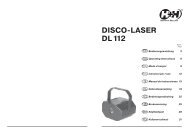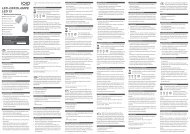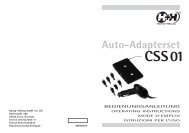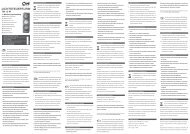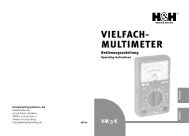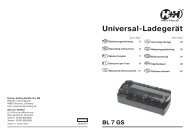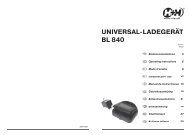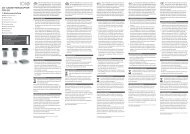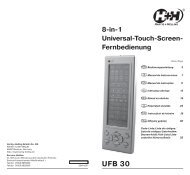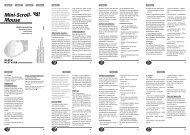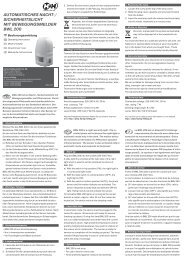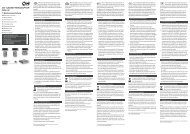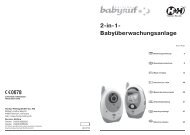BL 523/Bl505, Bed.-Anl. - Hartig + Helling GmbH & Co. KG
BL 523/Bl505, Bed.-Anl. - Hartig + Helling GmbH & Co. KG
BL 523/Bl505, Bed.-Anl. - Hartig + Helling GmbH & Co. KG
You also want an ePaper? Increase the reach of your titles
YUMPU automatically turns print PDFs into web optimized ePapers that Google loves.
POWER LADEN/ENTLADEN ENTLADEN<br />
POWER LADEN/ENTLADEN<br />
ENTLADEN<br />
2,4V 4,8V<br />
2,4V 4,8V<br />
POWER<br />
Schnellladegerät für NiCd- und NiMH-Akkus<br />
LADEN/ENTLADEN ENTLADEN<br />
POWER LADEN/ENTLADEN<br />
ENTLADEN<br />
2,4V 4,8V<br />
2,4V 4,8V<br />
POWER<br />
LADEN/ENTLADEN ENTLADEN<br />
POWER LADEN/ENTLADEN<br />
ENTLADEN<br />
2,4V 4,8V<br />
2,4V 4,8V<br />
POWER<br />
Schnellladegerät für NiCd- und NiMH-Akkus<br />
LADEN/ENTLADEN ENTLADEN<br />
POWER LADEN/ENTLADEN<br />
ENTLADEN<br />
2,4V 4,8V<br />
2,4V 4,8V<br />
POWER<br />
LADEN/ENTLADEN ENTLADEN<br />
POWER LADEN/ENTLADEN<br />
ENTLADEN<br />
2,4V 4,8V<br />
2,4V 4,8V<br />
POWER<br />
Schnellladegerät für NiCd- und NiMH-Akkus<br />
LADEN/ENTLADEN ENTLADEN<br />
POWER LADEN/ENTLADEN<br />
ENTLADEN<br />
2,4V 4,8V<br />
2,4V 4,8V<br />
POWER<br />
LADEN/ENTLADEN ENTLADEN<br />
POWER LADEN/ENTLADEN<br />
ENTLADEN<br />
2,4V 4,8V<br />
2,4V 4,8V<br />
POWER<br />
Schnellladegerät für NiCd- und NiMH-Akkus<br />
LADEN/ENTLADEN ENTLADEN<br />
POWER LADEN/ENTLADEN<br />
ENTLADEN<br />
2,4V 4,8V<br />
2,4V 4,8V<br />
AKKU-<br />
LADEGERÄT<br />
<strong>Bed</strong>ienungsanleitung<br />
Operating instructions<br />
Mode d’emploi<br />
Istruzioni per l’uso<br />
<strong>BL</strong> <strong>523</strong> GS/<strong>BL</strong> 505 GS<br />
<strong>Hartig</strong>&<strong>Helling</strong> <strong>GmbH</strong>&<strong>Co</strong>. <strong>KG</strong><br />
Hafenstraße 280<br />
45356 Essen, Germany<br />
Telefon 0201/32066-0<br />
Telefax 0201/3206655<br />
http://www.hartig-helling.de<br />
Das <strong>BL</strong> <strong>523</strong> GS/<strong>BL</strong> 505 GS ist ein Schnellladegerät<br />
für NiCd-und NiMH-Akkus der Größen<br />
Micro (AAA) und Mignon (AA). Die Akkus können<br />
mit diesem Ladegerät paarweise (2 oder 4)<br />
geladen werden. Neben den Funktionen Entladen,<br />
Schnellladen und Erhaltungsladen verfügt<br />
das Ladegerät über eine Spannungsüberwachungsfunktion<br />
(-∆U), wodurch keine Überladung<br />
der Akkus möglich ist.<br />
Bei den ersten Ladevorgängen kann das Gerät durch<br />
Wärmeentwicklung, die beim Laden entsteht, etwas riechen.<br />
Dabei handelt es sich nicht um einen Gerätefehler, sondern<br />
um einen völlig normalen Vorgang, der sich nach einigen<br />
Ladungen verflüchtigt.<br />
Bitte beachten Sie, dass nur Akkus mit gleicher Größe<br />
paarweise geladen werden können, d.h., Sie können mit dem<br />
<strong>BL</strong> <strong>523</strong> GS/<strong>BL</strong> 505 GS nicht gleichzeitig einen Mignon- und<br />
einen Micro-Akku als Paar laden.<br />
richtig falsch falsch falsch<br />
Laden von akkus mit vorheriger entladung<br />
POWER<br />
1 2 3<br />
1. Vor dem Laden verbinden Sie das <strong>BL</strong><strong>523</strong> GS/<strong>BL</strong> 505 GS mit<br />
Ihrem Stromnetz (230V AC).<br />
2. Sobald das Ladegerät mit dem Netz verbunden ist, leuchtet<br />
die rote LED „POWER“ (1) auf.<br />
3. Wählen Sie aus, ob Sie zwei oder vier Akkus laden wollen.<br />
Wenn Sie zwei Akkus laden möchten, muss der Spannungsumschalter<br />
auf 2,4 Volt gestellt werden. Wenn Sie vier Akkus<br />
laden möchten, muss der Schalter in Stellung 4,8 Volt gebracht<br />
werden.<br />
4. Legen Sie die Akkus in die dafür vorgesehenen Lademulden.<br />
5. Drücken Sie nun auf den Entladeknopf (3), um den Entladevorgang<br />
zu starten. Der Entladevorgang wird Ihnen dadurch<br />
angezeigt, dass die LED „LADEN/ENTLADEN“ (2) gelb<br />
aufleuchtet.<br />
6. Nachdem der Entladevorgang beendet ist, schaltet das Ladegerät<br />
automatisch auf Schnellladen um. Das Laden wird Ihnen durch<br />
die rot aufleuchtende LED „LADEN/ENTLADEN“ (2) angezeigt.<br />
7. Sobald Ihre Akkus aufgeladen sind, schaltet das Ladegerät<br />
auf Erhaltungsladung um. Die grün aufleuchtende LED<br />
„LADEN/ENTLADEN“ (2) signalisiert Ihnen die Erhaltungsladung.<br />
Laden von Akkus ohne vorherige Entladung<br />
1. Vor dem Laden verbinden Sie das <strong>BL</strong> <strong>523</strong> GS/<strong>BL</strong> 505 GS mit<br />
Ihrem Stromnetz (230V AC).<br />
2. Sobald das Ladegerät mit dem Netz verbunden ist, leuchtet<br />
die links befindliche rote LED „POWER“ (1) auf.<br />
3. Wählen Sie aus, ob Sie zwei oder vier Akkus laden wollen.<br />
Wenn Sie zwei Akkus laden möchten, muss der Spannungsumschalter<br />
auf 2,4 Volt gestellt werden. Wenn Sie vier Akkus<br />
laden möchten, muss der Schalter in Stellung 4,8 Volt gebracht<br />
werden.<br />
4. Legen Sie nun Ihre Akkus in die dafür vorgesehenen Lademulden,<br />
ohne dass der Entladeknopf gedrückt wird.<br />
5. Sobald Ihre Akkus eingelegt sind, leuchtet die LED<br />
„LADEN/ENTLADEN“ (2) rot auf und signalisiert Ihnen den<br />
Ladevorgang.<br />
6. Wenn Ihre Akkus aufgeladen sind, schaltet das Ladegerät auf<br />
Erhaltungsladung um. Die grün aufleuchtende LED<br />
„LADEN/ENTLADEN“ (2) signalisiert Ihnen die Erhaltungsladung.<br />
Sicherheitshinweise<br />
Achtung: Versuchen Sie niemals, alkalische Batterien oder<br />
RAM-Zellen (wiederaufladbare Batterien) zu laden. Es besteht<br />
Explosionsgefahr!<br />
92HH0204<br />
LADEN/ENTLADEN<br />
ENTLADEN<br />
2,4V 4,8V<br />
Lade- und Entladetabelle<br />
Die nachfolgende Tabelle gibt Ihnen einen Überblick über Ladeund<br />
Entladezeiten der hochwertigen H+H-NiCd- und NiMH-<br />
Akkus:<br />
Akkutyp Bauart Kapazität Ladezeit ca. Entladezeit ca.<br />
Micro AAA NiCd 240 mAH 1,5 Std. 4 Std.<br />
Micro AAA NiMH 550 mAH 3,5 Std. 6 Std.<br />
Mignon AA NiCd 600 mAH 2 Std. 10 Std.<br />
Mignon AA NiCd 1000 mAH 3 Std. 14 Std.<br />
Mignon AA NiMH 1200 mAH 4 Std. 20 Std.<br />
Mignon AA NiMH 2300 mAH 6,5 Std. 30 Std.<br />
Die in der Tabelle aufgeführten Lade- und Entladezeiten sind<br />
nur ungefähre Angaben. Diese Angaben können unter Umständen<br />
sehr starke Abweichungen aufweisen. Die Abweichungen hängen<br />
z.B. vom Alter der Akkus oder vom zu häufigen Laden ohne<br />
vorherige Entladung (siehe „Was heißt Memory-Effekt“) ab.<br />
Die Werte für die Lade- und Entladezeiten beziehen sich auf<br />
vollständig entladene bzw. geladene Akkus.<br />
Verbraucherhinweis<br />
Bitte beachten Sie, dass alle neuen NiCd- und NiMH-Akkus erst<br />
nach 4-6 Ladevorgängen die volle Kapazität erreichen.<br />
Was heißt Memory-Effekt?<br />
Werden NiCd-Akkus längere Zeit wiederholt nur teilentladen<br />
und danach sofort wieder voll aufgeladen, so steht Ihnen nur<br />
noch diese ständig bewegte Teilkapazität des Akkus zur Verfügung.<br />
Ein Phänomen, das als sog. „Memory-Effekt“ bezeichnet wird.<br />
D. h., Ihr Akku verfügt nicht mehr über die volle Kapazität, und<br />
das nur deshalb, weil er mehrmals nicht vollständig entladen<br />
wurde. Nur noch die relativ geringe Teilkapazität steht Ihnen zur<br />
Verfügung. Im Extremfall kann dies dazu führen, dass der Akku<br />
überhaupt nicht mehr geladen werden kann.<br />
Leisten Sie einen Beitrag zum Umweltschutz!<br />
Wenn <strong>BL</strong> <strong>523</strong> GS/<strong>BL</strong> 505 GS eines Tages ausgedient hat, sollten<br />
Sie das Gerät nicht einfach in den Hausmüll werfen. Sicher gibt<br />
es in Ihrer Gemeinde einen Wertstoff- oder Recyclinghof. Diese<br />
sorgen für eine umweltfreundliche Entsorgung Ihres Altgerätes.<br />
Verbrauchte Batterien und Akkumulatoren (Akkus), die mit<br />
einem der abgebildeten Symbole gekennzeichnet sind, dürfen<br />
nicht mit dem Hausmüll entsorgt werden.<br />
Sie müssen sie bei einer Sammelstelle für Altbatterien bzw. Sondermüll<br />
(informieren Sie sich bitte bei Ihrer Gemeinde) oder bei<br />
Ihrem Händler, bei dem Sie sie gekauft haben, abgeben. Diese<br />
sorgen für eine umweltfreundliche Entsorgung.<br />
Pflege und Gewährleistung<br />
Trennen Sie das Gerät vor dem Reinigen gegebenenfalls von<br />
anderen Komponenten und verwenden Sie bitte keine aggressiven<br />
Reiniger.<br />
Das Gerät wurde einer sorgfältigen Endkontrolle unterzogen.<br />
Sollten Sie trotzdem Grund zu einer Beanstandung haben, senden<br />
Sie uns das Gerät mit der Kaufquittung ein. Wir bieten eine<br />
Gewährleistung von 3 Jahren ab Kaufdatum.<br />
Für Schäden, die durch falsche Handhabung, unsachgemäße<br />
Nutzung oder Verschleiß verursacht wurden, übernehmen wir<br />
keine Haftung.<br />
Technische Änderungen sind vorbehalten.<br />
Aktuelle Produktinformationen finden Sie auf unserer Internet-Seite<br />
http://www.hartig-helling.de.<br />
Technische Daten<br />
Eingang:<br />
230V AC/50 Hz/6,6 Watt<br />
Ausgang:<br />
2,4V DC/4,8V DC/2,8 VA (max.)<br />
Ausgang<br />
Mikro (AAA): Ladestrom 300 mA<br />
Ausgang<br />
Mignon (AA): Ladestrom 500 mA<br />
Erhaltungsladung (AAA): 30 mA<br />
Erhaltungsladung (AA): 50 mA<br />
<strong>BL</strong> <strong>523</strong> GS/<strong>BL</strong> 505 GS is a high-rate charger for<br />
AAA and AA-sized NiCd and NiMH accumulators.<br />
The charger can charge the accumulators in<br />
pairs (2 or 4). In addition to the functions<br />
discharging, high-rate charging and floating,<br />
the charger is provided with a voltage<br />
monitoring function (-∆U) to avoid overcharging<br />
of the accumulators.<br />
During the initial charging operations the charger may smell<br />
due to heat development when charging. This is not a fault<br />
of the device but a quite normal phenomenon which disappears<br />
after a few charging operations.<br />
Please note that only accumulators of the same size can be<br />
charged in pairs, i.e. it is not possible to charge a pair of AA<br />
and AAA-sized accumulators simultaneously.<br />
right false false false<br />
Charging the accumulators with prior<br />
discharging<br />
POWER<br />
LADEN/ENTLADEN<br />
ENTLADEN<br />
2,4V 4,8V<br />
1 2 3<br />
1. Prior to charging connect <strong>BL</strong> <strong>523</strong> GS/<strong>BL</strong> 505 GS with your<br />
mains (230V AC).<br />
2. As soon as the charger is connected with the mains, the left<br />
red “POWER” LED (1) lights up.<br />
3. Now select whether to charge two or four accumulators. Set<br />
the voltage change-over switch to 2.4V for two accumulators<br />
and to 4.8V when charging four accumulators.<br />
4. Now insert the accumulators in the compartment provided for<br />
this purpose.<br />
5. Press the discharging button (3) to start discharging. Discharging<br />
is displayed by the yellow “LADEN/ENTLADEN” LED (2).<br />
6. On completion of discharging, the charger changes over to<br />
high-rate charging automatically. Charging is indicated by the<br />
red “LADEN/ENTLADEN” LED (2).<br />
7. As soon as the accumulators are charged, the charger changes<br />
over to floating. Floating is indicated by the green<br />
“LADEN/ENTLADEN” LED (2).<br />
Charging accumulators without prior<br />
discharging<br />
1. Prior to charging connect <strong>BL</strong> <strong>523</strong> GS/<strong>BL</strong> 505 GS with your<br />
mains (230V AC).<br />
2. As soon as the charger is connected with the mains, the left<br />
red “POWER” LED (1) lights up.<br />
3. Now select whether to charge two or four accumulators. Set<br />
the voltage change-over switch to 2.4V for two accumulators<br />
and to 4.8V when charging four accumulators.<br />
4. Now insert the accumulators in the compartment provided for<br />
this purpose without pressing the discharging button.<br />
5. As soon as the accumulators are inserted the red<br />
“LADEN/ENTLADEN” LED (2) lights up to signal charging.<br />
6. As soon as the accumulators are charged, the charger changes<br />
over to floating. Floating is indicated by the green<br />
“LADEN/ENTLADEN” LED (2).<br />
Safety notes<br />
Important: Never try to charge alkaline batteries or RAM<br />
cells (re-chargeable batteries). Danger of explosion!<br />
Charging and discharging table<br />
The following table shows the charging and discharging times<br />
of some commercial accumulators:<br />
Type Design Capacity Charg Discharg.<br />
time appr. time appr.<br />
Micro AAA NiCd 240 mAH 1.5 h 4 h<br />
Micro AAA NiMH 550 mAH 3.5 h 6 h<br />
Mignon AA NiCd 600 mAH 2 h 10 h<br />
Mignon AA NiCd 1000 mAH 3 h 14 h<br />
Mignon AA NiMH 1200 mAH 4 h 20 h<br />
Mignon AA NiMH 2300 mAH 6.5 h 30 h<br />
The charging and discharging times given in the table are<br />
approximate values only which might considerably vary under<br />
certain circumstances. These variances depend, e.g., on the age<br />
of the accumulators or too frequent charging without prior<br />
discharging (refer to “Memory effect”).<br />
The values for the charging and discharging times are applicable<br />
to completely discharged and/or charged accumulators.<br />
Hints for users<br />
Please note that all new NiCd and NiMH accumulators reach<br />
their full capacity only after 4–6 charging operations.<br />
What is the memory effect?<br />
If NiCd accumulators are only partially discharged over a longer<br />
period of time and then fully charged immediately, only that<br />
continuously changing partial capacity is available.<br />
A phenomenon, the so-called “memory effect”, i.e., your<br />
accumulator has not the full capacity because it was not discharged<br />
completely for several times. Only the relatively low partial<br />
capacity is available then. In extreme cases this can mean that<br />
it is impossible to charge the accumulator.<br />
Help protect the environment!<br />
When the <strong>BL</strong> <strong>523</strong> GS/<strong>BL</strong> 505 GS one day comes to the end of<br />
its useful life, you should not simply throw it into the garbage<br />
can. There is certainly a facility in you area for disposing of such<br />
equipment. This will ensure an environmentally friendly disposal.<br />
Batteries and storage cells bearing one of the undermentioned<br />
symbols must not be disposed of in normal domestic waste.<br />
Instead take them to a collecting point for old batteries or special<br />
waste products (ask your local authority for details) or return<br />
them to the dealer you bought them from. He will ensure they<br />
are disposed of safely.<br />
Care and warranty<br />
Separate the device from other components prior to cleaning, if<br />
necessary, do not use aggressive cleansing agents.<br />
The device has been subjected to a careful final inspection. In<br />
case of complaints, however, please return the device together<br />
with the receipt. We grant a guarantee period of 3 years from the<br />
date of purchase.<br />
No claims will be accepted for damage due to wrong handling,<br />
improper use or wear.<br />
We reserve the right for technical modifications.<br />
Technical data<br />
Input:<br />
Output:<br />
Output AAA:<br />
Output AA:<br />
Floating voltage AAA:<br />
Floating voltage AA:<br />
230V AC/50 Hz/6.6W<br />
2.4V DC/4.8V DC/2.8 VA (max.)<br />
charging current 300 mA<br />
charging current 500 mA<br />
30 mA<br />
50 mA<br />
For current product information please refer to our Internet Site<br />
http://www.hartig-helling.de.<br />
Le <strong>BL</strong> <strong>523</strong> GS/<strong>BL</strong> 505 GS est un chargeur rapide<br />
pour accus NiCd et NiMH LR03 (AAA) et LR6<br />
(AA). Les accus peuvent être chargés par paire<br />
avec cet appareil (2 ou 4). Outre les fonctions<br />
décharge, charge rapide et charge de maintien,<br />
l'appareil dispose d'une fonction de contrôle<br />
de tension (-∆U) évitant ainsi toute surcharge<br />
des accus.<br />
Lors des premières opérations de charge, l'appareil peut<br />
dégager certaines odeurs lors de la charge dû à la chaleur.<br />
Il ne s'agit pas d'une défaillance de l'appareil mais d'un<br />
phénomène tout à fait normal qui disparaît après quelques<br />
charges.<br />
Tenir compte du fait que seuls des accus de mêmes dimensions<br />
peuvent être chargés par paire c'est-à-dire avec le<br />
<strong>BL</strong> <strong>523</strong> GS/<strong>BL</strong> 505 GS, il n'est pas possible de charger en<br />
même temps un accu LR6 et un accu LR03 en paire.<br />
correct incorrect incorrect incorrect<br />
Charge d'accus après décharge préalable<br />
POWER<br />
LADEN/ENTLADEN<br />
ENTLADEN<br />
2,4V 4,8V<br />
1 2 3<br />
1. Avant la charge, connecter le <strong>BL</strong> <strong>523</strong> GS/<strong>BL</strong> 505 GS au réseau<br />
(230V c.a.).<br />
2. Dès que le chargeur est connecté au réseau, la DEL «POWER»<br />
(1) se trouvant à gauche s'allume.<br />
3. Choisir si deux ou quatre accus doivent être chargés. Pour<br />
deux accus, le commutateur de tension doit être réglé sur<br />
2,4V; pour 4 accus, ce commutateur doit être sur 4,8V.<br />
4. Placer les accus dans le compartiment de charge prévu à cet<br />
effet.<br />
5. Appuyer sur le bouton de décharge (3) pour démarrer l'opération<br />
de décharge qui est indiquée lorsque la DEL<br />
«LADEN/ENTLADEN» (2) passe au jaune.<br />
6. Après la décharge, l'appareil passe automatique sur charge<br />
rapide. La charge est indiquée la DEL «LADEN/ENTLADEN»<br />
(2) qui passe au rouge.<br />
7. Dès que les accus sont chargés, le chargeur passe sur charge<br />
de maintien. La DEL «LADEN/ENTLADEN» (2) passe au<br />
vert et indique que la charge de maintien est en cours.<br />
Charge d'accus sans décharge préalable<br />
1. Avant la charge, connecter le <strong>BL</strong> <strong>523</strong> GS/<strong>BL</strong> 505 GS au réseau<br />
(230V c.a.).<br />
2. Dès que le chargeur est connecté au réseau, la DEL «POWER»<br />
(1) se trouvant à gauche s'allume.<br />
3. Choisir si deux ou quatre accus doivent être chargés. Pour<br />
deux accus, le commutateur de tension doit être réglé sur<br />
2,4V; pour 4 accus, ce commutateur doit être sur 4,8V.<br />
4. Placer les accus dans le compartiment de charge prévu à cet<br />
effet sans appuyer sur le bouton de décharge.<br />
5. Dès que les accus sont placés, la DEL «LADEN/ENTLADEN»<br />
(2) passe au rouge et indique que l'opération de charge est en<br />
cours.<br />
6. Dès que les accus sont chargés, le chargeur passe sur charge<br />
de maintien. La DEL «LADEN/ENTLADEN» (2) passe au<br />
vert et indique que la charge de maintien est en cours.<br />
<strong>Co</strong>nsignes de sécurité<br />
Attention: Ne jamais essayer de charger des piles alcalines<br />
ou des cellules RAM (piles rechargeables). Danger d'explosion.<br />
Tableau de charge et de décharge<br />
Le tableau suivant donne une vue d'ensemble sur les durées de<br />
charge et de décharge pour les accus les lus courants:<br />
Type Modèle Capacité Durée de Durée de<br />
charge décharge<br />
approx. approx.<br />
LR03 AAA NiCd 240 mAH 1,5 h 4 h<br />
LR03 AAA NiMH 550 mAH 3,5 h 6 h<br />
LR6 AA NiCd 600 mAH 2 h 10 h<br />
LR6 AA NiCd 1000 mAH 3 h 14 h<br />
LR6 AA NiMH 1200 mAH 4 h 20 h<br />
LR6 AA NiMH 2300 mAH 6,5 h 30 h<br />
Les durées de charge et de décharge indiquées dans le tableau<br />
ne sont que des données approximatives. Ces données peuvent<br />
éventuellement présenter des différences importantes. Ces<br />
différences dépendent par exemple de l'âge des accus ou de<br />
charges trop fréquentes sans décharge préalable (voir «EFFET<br />
MÉMOIRE»).<br />
Les valeurs de charge et de décharge se réfèrent à des accus<br />
entièrement déchargés ou chargés.<br />
<strong>Co</strong>nsigne d'utilisation<br />
Tenir compte du fait que tous les nouveaux accus NiCd et NiMH<br />
n'atteignent leur pleine capacité qu'après 4–6 charges.<br />
Que signifie l'effet mémoire?<br />
Si une pile NiCd n'est déchargée à plusieurs reprises que<br />
partiellement puis ensuite rechargée, la pile ne dispose plus que<br />
de cette capacité partielle constamment en mouvement. Un<br />
phénomène que l'on désigne par «effet mémoire». La pile ne<br />
dispose donc plus de la pleine capacité car elle n'a pas été chargée<br />
complètement à plusieurs reprises.<br />
Elle ne dispose plus que de la capacité partielle relativement<br />
faible et, dans un cas extrême, il peut arriver qu'une pile ne puisse<br />
plus être rechargée.<br />
Protegeons notre environnement!<br />
Au terme de l'utilisation, l'appareil <strong>BL</strong> <strong>523</strong> GS/<strong>BL</strong> 505 GS ne<br />
doit pas être rejeté avec les ordures ménagères. Vous trouverez<br />
très certainement dans votre commune un service de collecte<br />
des matériaux ou de recyclage qui se chargera du rejet des déchets<br />
en respectant les contraintes environnementales.<br />
Vous ne devez pas jeter les piles et accumulateurs qui portent<br />
les symboles avec les déchets ménagers.<br />
Veuillez les déposer dans un lieu destiné à recueillir les piles<br />
usagées ou autres déchets de type spécial (renseignez-vous auprès<br />
des autorités locales), ou les retourner à votre fournisseur qui<br />
s’assurera qu’elles seront éliminées sans danger.<br />
Entretien et garantie<br />
Avant le nettoyage, coupez si nécessaire l’appareil d'autres<br />
composants et n'utilisez pas de produits de nettoyage agressifs.<br />
L’appareil a été soumis à un contrôle final minutieux. Si vous<br />
deviez toutefois avoir une réclamation, envoyez-nous les appareils<br />
avec le bon d'achat. Nous proposons une garantie de 3 ans à<br />
compter de la date d'achat.<br />
Nous ne nous portons pas garants pour les dommages occasionnés<br />
par une manipulation incorrecte, une utilisation non conforme<br />
ou l'usure.<br />
Sous toutes réserves de modifications techniques.<br />
Spécifications techniques<br />
Entrée:<br />
230V c.a./50 Hz/6,6W<br />
Sortie:<br />
2,4V c.c./4,8V c.c./2,8 VA<br />
(max.)<br />
Sortie LR03 (AAA):<br />
courant de charge 300 mA<br />
Sortie LR6 (AA):<br />
courant de charge 500 mA<br />
Charge de maintien LR03 (AAA): 30 mA<br />
Charge de maintien LR6 (AA): 50 mA<br />
Notre site Internet http://www.hartig-helling.de<br />
vous informe sur les produits actuels.<br />
il <strong>BL</strong> <strong>BL</strong> <strong>523</strong> GS/505 GS è un caricabatteria<br />
rapido per accumulatori al NiCd o al NiMH nei<br />
formati Micro (AAA) e mignon (AA). Questo<br />
caricabatteria permette di caricare gli<br />
accumulatori a coppie (2 o 4). Oltre alle funzioni<br />
di scarica, carica rapida e carica di<br />
mantenimento, il caricabatteria è dotato di una<br />
funzione di controllo di tensione (-∆U) grazie<br />
alla quale si evita una sovraccarica degli<br />
accumulatori.<br />
Durante le prime operazioni di carica, lo sviluppo di calore<br />
causato dal processo di carica può essere accompagnato dalla<br />
formazione di odore. Ciò non è dovuto a nessun difetto<br />
dell’apparecchio, bensì si tratta di un fatto del tutto normale<br />
che, dopo alcune operazioni di carica, non tornerà a ripetersi.<br />
Si tenga presente che è possibile caricare a coppie solo<br />
accumulatori dello stesso formato.<br />
Ciò significa che il <strong>523</strong> GS/505 GS non permette di caricare<br />
contemporaneamente una coppia formata da un accumulatore<br />
in formato mignon ed uno in formato micro.<br />
giusto sbagliato sbagliato sbagliato
Carica di accumulatori con prescarica<br />
POWER<br />
LADEN/ENTLADEN<br />
ENTLADEN<br />
2,4V 4,8V<br />
1 2 3<br />
1. Prima di eseguire la carica, collegate il <strong>BL</strong> <strong>523</strong> GS/<br />
<strong>BL</strong> 505 GS alla rete di alimentazione elettrica (230V c.a.).<br />
2. Non appena l’apparecchio è collegato all’alimentazione<br />
elettrica, la spia luminosa rossa «POWER» (1), disposta nel<br />
lato sinistro, si accende.<br />
3. Scegliete tra la carica di due o di quattro accumulatori. Se<br />
desiderate caricare due accumulatori, il commutatore della<br />
tensione va posizionato su 2,4 volt, se desiderate caricare<br />
quattro accumulatori, il commutatore va posizionato su 4,8<br />
volt.<br />
4. Inserite i vostri accumulatori nelle conchette di carica previste<br />
a tale scopo.<br />
5. Premete quindi il tasto di scarica (3) in modo da avviare<br />
l’operazione di scarica. L’accensione in giallo della spia di<br />
«LADEN/ENTLADEN» (2) indica che è in corso l’operazione<br />
di scarica.<br />
6. Al termine dell’operazione di scarica, il caricabatteria si<br />
commuta automaticamente sulla carica rapida. Ciò è indicato<br />
dall’illuminazione in rosso della spia di<br />
«LADEN/ENTLADEN» (2).<br />
7. Dopo che gli accumulatori si sono caricati, il caricabatteria<br />
si commuta sulla carica di mantenimento. La carica di<br />
mantenimento viene segnalata dall’illuminazione in verde<br />
della spia di «LADEN/ENTLADEN» (2).<br />
Carica di accumulatori senza prescarica<br />
1. Prima di eseguire la carica, collegate il <strong>BL</strong> <strong>523</strong> GS/<br />
<strong>BL</strong> 505 GS alla rete di alimentazione elettrica (230V c.a.).<br />
2. Non appena l’apparecchio è collegato all’alimentazione<br />
elettrica, la spia luminosa rossa «POWER» (1), disposta nel<br />
lato sinistro, si accende.<br />
3. Scegliete tra la carica di due o di quattro accumulatori. Se<br />
desiderate caricare due accumulatori, il commutatore della<br />
tensione va posizionato su 2,4 volt, se desiderate caricare<br />
quattro accumulatori, il commutatore va posizionato su 4,8<br />
volt.<br />
4. Inserite i vostri accumulatori nelle conchette di carica previste<br />
a tale scopo, senza premere il tasto di scarica.<br />
5. Subito dopo avere inserito gli accumulatori, la spia di<br />
«LADEN/ENTLADEN» (2) si illumina in rosso indicando<br />
che è in corso l’operazione di carica.<br />
6. Dopo che gli accumulatori si sono caricati, il caricabatteria<br />
si commuta sulla carica di mantenimento. La carica di<br />
mantenimento viene segnalata dall’illuminazione in verde<br />
della spia di «LADEN/ENTLADEN» (2).<br />
Istruzioni per la sicurezza<br />
Attenzione! Non cercate mai di caricare pile alcaline oppure<br />
celle RAM (pile ricaricabili). Pericolo di esplosione!<br />
Tabella di carica e scarica<br />
La seguente tabella vi offre un quadro generale delle durate di<br />
carica e scarica relative ai tipi di accumulatore più correnti:<br />
Accumulatore Tipo Capacità Durata di Durata di<br />
carica circa scarica<br />
circa<br />
Micro AAA NiCd 240 mAH 1,5 ore 4 ore<br />
Micro AAA NiMH 550 mAH 3,5 ore 6 ore<br />
Mignon AA NiCd 600 mAH 2 ore 10 ore<br />
Mignon AA NiCd 1000 mAH 3 ore 14 ore<br />
Mignon AA NiMH 1200 mAH 4 ore 20 ore<br />
Mignon AA NiMH 2300 mAH 6,5 ore 30 ore<br />
Le durate di carica e scarica sono solo delle indicazioni<br />
approssimative.<br />
A seconda delle circostanze, tali indicazioni possono subire delle<br />
variazioni molto forti. Tali variazioni dipendono, per esempio,<br />
dall’invecchiamento degli accumulatori oppure dalla frequenze<br />
delle cariche eseguite senza prescarica (vedi «CHE COSA<br />
S’INTENDE PER EFFETTO MEMORIA?»).<br />
I dati sui tempi di carica e scarica sono relativi agli accumulatori<br />
caricati ovvero scaricati completamente.<br />
Avviso per i consumatori<br />
Si tenga presente che tutti i nuovi accumulatori al NiCd e<br />
al NiMH raggiungono la piena capacità soltanto dopo 4-6<br />
operazioni di carica.<br />
Che cosa s’intende per effetto memoria?<br />
Se gli accumulatori vengono ripetutamente scaricati solo in<br />
misura parziale, per poi essere ricaricati a fondo, vi rimane<br />
disponibile soltanto tale capacità parziale degli accumulatori che<br />
viene messa in continuo movimento. A questo fenomeno si suole<br />
dare il nome di «Effetto Memoria». Ciò significa che il vostro<br />
accumulatore non dispone più della sua piena capacità, in quanto<br />
per diverse volte non è stato scaricato completamente. Vi è<br />
disponibile solo una capacità parziale relativamente esigua, la<br />
qual cosa, in casi estremi, può far sì che l’accumulatore non<br />
possa più essere ricaricato affatto.<br />
<strong>Co</strong>ntribuite alla tutela dell’ambiente!<br />
Quando un giorno <strong>BL</strong> <strong>523</strong> GS/<strong>BL</strong> 505 GS verrà messo fuori<br />
esercizio, non dovete gettare l’apparecchio semplicemente nei<br />
rifiuti domestici. Sicuramente nel vostro comune vi è un punto<br />
di raccolta dei materiali riutilizzabili o di riciclaggio. Questi<br />
provvedono ad uno smaltimento ecologico del vostro apparecchio<br />
vecchio.<br />
Non si devono smaltire insieme con i rifiuti domestici le batterie<br />
e gli accumulatori consumati, che sono contrassegnati con i<br />
simboli indicati di seguito.<br />
Tali prodotti devono essere consegnati in un centro di raccolta<br />
per batterie consumate o per rifiuti industriali (pregasi informarsi<br />
presso l’ufficio comunale), oppure al rivenditore presso il quale<br />
si è acquistato l’apparecchio. Il centro di raccolta e il rivenditore<br />
provvederanno poi ad uno smaltimento ecocompatibile.<br />
Manutenzione e garanzia<br />
Prima di procedere alla pulizia dell’apparecchio lo si deve<br />
eventualmente scollegare dagli altri componenti e non si deve<br />
fare uso di detersivi corrosivi.<br />
L’apparecchio è stato sottoposto ad un accurato controllo finale.<br />
Se ciononostante avete motivi di reclamo, spediteci l’apparecchio<br />
unitamente alla ricevuta d’acquisto. La nostra azienda offre una<br />
garanzia di 3 anni a partire dalla data di acquisto.<br />
Si declina ogni responsabilità per danni dovuti a manipolazione<br />
errata, uso inappropriato o usura.<br />
<strong>Co</strong>n riserva di modifiche tecniche.<br />
Specifiche tecniche<br />
Entrata:<br />
Uscita:<br />
Uscita micro (AAA):<br />
Uscita mignon (AA):<br />
Carica di mantenimento (AAA):<br />
Carica di mantenimento (AA):<br />
230V c.a./50 Hz/6,6 watt<br />
2,4 c.c./4,8V c.c./2,8 VA<br />
(max.)<br />
corrente di carica 300 mA<br />
corrente di carica 500 mA<br />
30 mA<br />
50 mA<br />
Per informazioni aggiornate sui nostri prodotti consultate il nostro sito<br />
Internet : http://www.hartig-helling.de.



